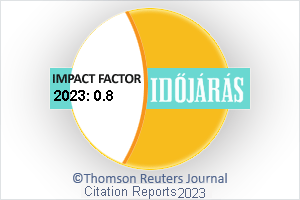IDŐJÁRÁS - angol nyelvű folyóirat
Vol. 127, No. 4 * Pages 421–504 * October - December 2023
 |
Special issue: Application of advanced methods used for specific environmental purposes Guest Editor: Kálmán Kovács |
 letöltés [pdf: 2891 KB]
letöltés [pdf: 2891 KB]
Contribution of data-driven methods to risk reduction and climate change adaptation in Hungary and beyond
Edina Birinyi, Boglárka O. Lakatos, Márta Belényesi, Dániel Kristóf, Zsolt Hetesi, László Mrekva, and Gábor Mikus
DOI:10.28974/idojaras.2023.4.1 (pp. 421–446)
Edina Birinyi, Boglárka O. Lakatos, Márta Belényesi, Dániel Kristóf, Zsolt Hetesi, László Mrekva, and Gábor Mikus
DOI:10.28974/idojaras.2023.4.1 (pp. 421–446)
Evaluating dehazing techniques on artificial and satellite land surface images
András Fridvalszky, Balázs Tóth, and László Szécsi
DOI:10.28974/idojaras.2023.4.2 (pp. 447–457)
András Fridvalszky, Balázs Tóth, and László Szécsi
DOI:10.28974/idojaras.2023.4.2 (pp. 447–457)
Forecasting critical weather front transitions based on locally measured meteorological data
Mátyás Szántó and László Vajta
DOI:10.28974/idojaras.2023.4.3 (pp. 459–471)
Mátyás Szántó and László Vajta
DOI:10.28974/idojaras.2023.4.3 (pp. 459–471)
A comparison of river streamflow measurement from optical and passive microwave radiometry
Zsófia Kugler and Viktor Győző Horváth
DOI:10.28974/idojaras.2023.4.4 (pp. 473–484)
Zsófia Kugler and Viktor Győző Horváth
DOI:10.28974/idojaras.2023.4.4 (pp. 473–484)
Climate change in the Debrecen area in the last 50 years and its impact on maize production
Béla Gombos, Zoltán Nagy, András Hajdu, and János Nagy
DOI:10.28974/idojaras.2023.4.5 (pp. 485–504)
Béla Gombos, Zoltán Nagy, András Hajdu, and János Nagy
DOI:10.28974/idojaras.2023.4.5 (pp. 485–504)
IDŐJÁRÁS folyóirat

Az IDŐJÁRÁS a HungaroMet Nonprofit Zrt. negyedévenként megjelenő angol nyelvű folyóirata
Megrendelhető a journal.idojaras@met.hu címen.
A szerzőknek szánt útmutató itt olvasható.
Megrendelhető a journal.idojaras@met.hu címen.
A szerzőknek szánt útmutató itt olvasható.









